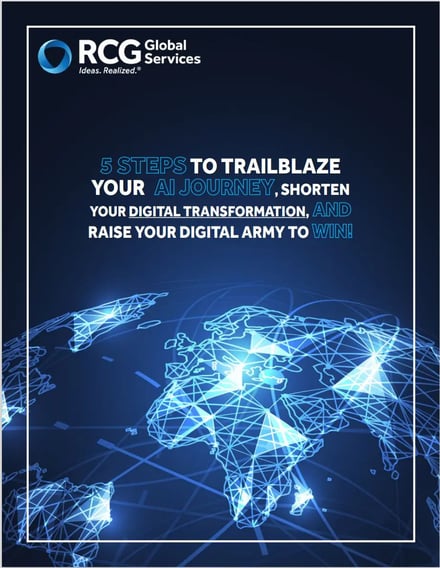5 Steps To Trailblaze Your AI Journey
When used correctly, artificial intelligence can transform a business. But are you leveraging AI to your full advantage?
Accelerate Your AI Strategy and Implementation

These forces can stress any business model. The great promise of artificial intelligence (AI) continues to be a “hyped” opportunity that eludes most firms in terms of broad actualization. While digital transformation is now a priority for the majority of organizations, only about 20% of AI-aware companies are currently using one or more AI technologies in a core business process at scale1 . As highlighted in a recent white paper, Beyond the Hype: 9 Secrets to Get Your AI Game On2 , the time is now to make your AI-Powered business model real.
Consider these five key actions:
- Understand where you are today with an AI Maturity check
- Strategically focus on Automation (RPA+AI) as “the tip of the AI spear.”
- Establish an automation and digital workforce COE
- Raise your digital workforce
- Scale and reap rewards
Related Resources
#1. Understand where you are today with an AI Maturity Check

Firms need to understand how they are positioned when it comes to AI and cognitive technologies which represent the most significant disruptive technology wave since the rise and globalization of the internet and mobile connectivity and computing.
Consider evaluating your firm against an AI maturity model. It is clear from RCG’s work with customers across many industries that the progress (or lack of) in AI maturity is marked not only by the prolonged deployment of AI, machine learning, and cognitive technologies, but also by the lack of sufficient resources (people and processes) to support a broad digital and intelligent transformation.
By understanding where you are today, you can help focus and track your efforts to the next level to achieve competitive advantage. Majority of companies are just getting started and many are still at level zero. If you are early, don’t feel too bad as the overall industry is still in the early phases of broad enterprise adoption. But you don’t have time to waste when it comes to making serious gains in the creation of value in your business model using AI. Gartner predicts that by 2020, 40% of large enterprises will have adopted robotic process automation (RPA), up from less than 10% today.3 So, if you haven’t yet, you must get started, and there are lots of great reasons to do so. To keep things simple, consider this very straight forward method of maturity analysis consisting of 4 stages4,5 several of which are conceptualized by award-winning innovation author Jedidiah Yueh as well as one shared on Avande Insights by Aaron Reich.
Have you started any AI programs yet?
RCG has blended concepts and made some adaptation below based on our experience: Level Zero: If you haven’t started any AI programs at all, you are at
Level Zero. If you are here, it means you are already falling fast behind the rest of the universe!
You likely are faced with questions about getting started.
- What part of the business should we start with?
- How do we apply it?
- What ROI will we see?
- What, holistically, are we hoping to achieve?
Level One: Are you applying AI to a practical, internal project, with a clear target benefit? Level One businesses are heading in the right direction but have a way to go before they are able to realize the real value of AI in a significant way.
At Level One, firms use AI programs to drive performance improvement, productivity, and operational efficiency and possibly go-to-market effectiveness. They may be just starting to implement AI in their products and services. These businesses, however, are not deeply engaged or committed. They may be large organizations that are driving hundreds of millions or even billions in revenues each year but only saving a small percentage of operating costs by using AI to automate tasks previously done by humans. Level One firms usually apply AI to internal opportunities using a straightforward cost-benefit analysis and use AI services including chatbots, natural language processing (NLP), and robotic process automation (RPA) to eliminate manual, repetitive work. Often, there is still pushback and resistance to implementing. Sometimes these businesses struggle to get broader acceptance and struggle to scale. What can be striking, at this stage, however, is that some firms are actually deploying AI within their customer-facing products but barely using any to reinvent their business model and drive a higher value-producing model by adopting AI inside the business.
Level Two: Are you implementing AI throughout your business, making a meaningful difference in user experience, growth, revenues, or profit? Then you are operating at Level Two. Firms deploy AI programs to drive bigger resource re-alignment, significant earnings, or revenue impact. These businesses are “intelligent practitioners” – implementing AI, machine learning, and cognitive solutions throughout their organizations and using AI to transform their business model to drive user experience and customer value. They tangibly reimagine digital and even physical products with AI services, adding value, and improving interactions at every opportunity.
Level Three: Are you designing products that will redefine the future of your industry? Then you are operating at Level Three; enterprises leverage AI programs to drive industry change and transformation. This is currently the domain of big tech leader firms.
For those firms at Level Zero to Level Two:
The following steps are recommended to 1) accelerate your AI journey and 2) set the vital stage for raising your digital workforce. For firms that have achieved level three, congratulations! You are leading the way. Your focus should continue to be scale, institutionalize your digital workforce, and continue multi-technology Innovation and integration.
# 2. Strategically Focus on Automation as the “tip of the AI spear.”

Why start with automation?
Significant components of that model include the key resources and cost structure.6 These, together with value propositions, can be highly impacted by automation. Focusing on both internal opportunities as well as product-focused offers and differentiation by product/service can be a great way to innovate in the components of your model so you can focus better and capture more value. Consider contemporary RPA and evolving intelligent process automation (IPA) as a “tip of the spear” approach to drive AI innovation and adoption.
You can use RPA to drive quick wins, confidence, and adoption (e.g., change management). For example, RPA adoption in many enterprises starts as a tactical initiative. Once the pain-relieving solution, easy win and /or substantial results have been achieved, and users are fluent with critical features and capabilities, the use of an RPA platform is expanded to a broader range of use cases.7
Automating business processes provides many benefits. According to Forbes, automation can save employees up to nine weeks of effort each year, saving businesses millions of dollars annually8. Tangible benefits, including the following, can often be realized in a short period (weeks versus months, for example):
- Optimize labor costs, increase productivity and capacity
- Increase speed, accuracy (100%) and availability (24×365)
- Improve compliance, controls, and auditability
- Deliver business intelligence
- Enable digital transformation; faster digitization
- Enhance employee morale
- Improve customer experience, speed, and error-free delivery
Equally important, automation can also assist with incorporating Innovation into existing processes and lay the foundation for your ongoing Intelligent Innovation strategy and implementation. This is done by starting with automation as a means to the fast value-driven realization of AI (from hype to actual results). Despite the technological history, to think of automation and RPA as basic screen scraping would be naïve. Technology is moving fast.
RPA is no longer limited to predefined tasks and data. As we will further discuss, the trend is moving to Intelligent Process Automation (IPA). This involves AI-based smart bots which are capable of handling ambiguity and make decisions similar to their human counterparts. Because this “intelligent” or “cognitive” RPA is capable of analyzing both structured and unstructured data— as well as making business decisions—its value surpasses the more straight-forward automation of basic business process automation9 .
Yet, even basic automation can be a great starting point given that AI realization is a journey and not a destination.
According to McKinsey, 60% of job roles have at least 30% of activities that could be automated using currently demonstrated and available technologies10. There are four key features to consider when buying automation tools: RPA, cognitive automation capabilities, smart analytics, and access to pre-built bots.11 Thus, automation, and RPA are foundational components of any AI strategy and roadmap. RPA + AI is an excellent entry point for any company seeking to drive its AI strategy and implementation for several reasons:
- Automation does not require hiring lots of deep AI and technical experts. A priority for successful automation with RPA is to “democratize” AI across the business. It can be started in a bite-sized manner to drive fast results so that you can drive all the aspects of a project that need to be considered (not just tech).
- Automation is a foundational step in creating the digital workforce. The digital worker is made possible through multiple “bots” and cognitive tech to do a specific job or jobs.
- There are many opportunities for RPA, IPA, and “digital workers” to deliver significant value to firms struggling to leverage a patchwork quilt of existing systems. Automation can become a valuable asset to overcome legacy IT barriers as part of a transitional architecture that allows burdensome processes to be streamlined without ripping out and replacing significant systems. A unique business process that requires a variety of technologies – including historical legacy investments – can be seamlessly managed and deliver the most significant benefits from automation. Because RPA can interact with the metadata that drives modern applications at the UI level, it can help accomplish the following:
- Move data in or out of third-party application systems an “unattended” RPA. This uses straight-through task automation where scripts are designed to replicate the actions of a person using those systems, which, typically, do not have useful APIs.12
- Augment employees’ capabilities with “attended” Automation. RPA tools can extract information from systems and related documents, and then shape and prepare it for consumption by the user at the point of consumption/need.13
Robotic Process Automation (RPA) bots are being combined with the latest AI to raise a digital workforce, transform business models and industries, create real digital transformation, and deliver a true competitive advantage.14
#3 Establish and Automation and Digital workforce COE
-and-business-process-automation-technology-being-setup-by-IT-consultant-working-on-digital-tablet-computer.jpg?width=1200&height=675&name=Document-management-system-(DMS)-and-business-process-automation-technology-being-setup-by-IT-consultant-working-on-digital-tablet-computer.jpg)
They also may not have the right resources and organizational buy-in. As with any new technology, there are many reasons that firms’ efforts at automation and AI “sputter” or fail. Some challenges include RPA skills shortage, poor change management, lack of ownership, ill-defined success criteria, and disregard for infrastructure management considerations.15
Simply “ginning up” bots and throwing them at processes without an in-depth understanding of requirements or a clear strategy is not a winning approach. One approach that is trending amongst organizations with successful, intelligent automation programs is to create a center of excellence (COE) in order to foster and incubate automation and the digital workforce. These COE’s also address the strategy, resource, prioritization, new governance, security, and HR issues that arise from this transformation and to ensure that RPA initiatives remain on track and deliver business value. The COE provides the link between the strategic objectives and the organization and establishes the operating model blueprint – that combines strategy, accountability, and governance with key capabilities (people, process, and technology).
Firms have successfully taken different approaches to the COE and kickstarting and scaling an automation initiative. RCG participated in a recent Automation Anywhere users’ group in Chicago. Well-known firms such as Abbott, Harley Davidson, Bosch, GM, and STANT reported having used a variety of approaches to advance their automation journey successfully.
The key objectives of establishing a COE are:
| Widespread adoption of the digital workforce | Establish RPA and cognitive capability and enable functions within an enterprise to identify and automate opportunities. Enterprises scale RPA at speed based on “bot velocity” |
| Standardization | Establish a standard toolset, enable rapid bot configuration, and ensure consistent adoption of defined standards, methods, and toolkit usage across functional teams |
| Competency Management | Develop required skills and capacity for RPA. Establish a training and certification program to accelerate RPA deployment (aligned with the bot velocity plan) |
| License management and Bot marshaling | Enterprise and centralized licensing and reduced entry cost to incentivize adoption and support mobilization |
| Control framework | Manage firm risk by defining and applying policies and controls for bot implementation across the firm. Handle transition from a non-automated environment to an unattended automated environment |
Source: Automation Anywhere
Different models exist and may well need to shift and evolve over time as there are pros and cons of each. Some critical choices must be made when setting up a COE:
- Where should the COE sit in the organization?
- What should be the size of the COE?
- Can the COE components change over time?
- What skill sets do I need in the COE?
- What organizational aspects define the operating model?
- What are my priority business drivers?
There are also a number of criteria to consider in the selection of your model, which include:
- Geographic location: Consider where the automation will be deployed and the impact based on unique laws, regulations, or security restrictions.
- Resources: funding, internal skills, and partnerships for services and technology.
- Ownership: business or IT owned/driven program.
- Sponsorship: Business level of investment in training, creating bot champions, and supporting governance.
- Speed of implementation: the need for rapid scale or not.
Consider These Options in Terms of Resource and Organization
Resource options
- Partnership Model: To accelerate delivery of the automation solutions, hire a professional services firm like RCG and outsource the process set up, running the COE, and building of the bots especially when you have constraints related to bandwidth, resources, and skills.
- Accelerator Model: Set up a small core group and leverage a firm like RCG as a strategic advisor, accelerator, and source of capacity to help build bots and scale.
- Self-service Model: Dive in directly and manage all of it on your COE, integration, bot building needs.
Ownership Options
- Business Unit Driven: This typically involves localized robotics implementations, governance, and maintenance. Most organizations adopt this model in the short-term before transitioning to either a federated or centralized operating mode
| Pros: | Simpler set-up. Ownership is localized, scale independently, quick implementation(s) |
| Cons: | Not scalable to the enterprise. Fragmented use of people, process/standards and technology |
- Federated Model: In this model, the delivery of bots is carried out by the business. An RPA COE is regionally centralized and provides best practices and guidance under the governance of a central governing body
| Pros: | Centralized standards, localized ownership, scalability, agility and domain knowledge |
| Cons: | Lack of role clarity may lead to conflict. Progress for certain Regions can fall behind |
- Centralized Model: A centralized robotics COE essentially functions as a shared service and delivers end-to-end RPA solutions enterprise-wide
| Pros: | Centralized standards and delivery, skill leverage is optimized and fully utilized |
| Cons: | Competing priorities can slow down highly agile Business Unit |
A recent case study17 by Automation Anywhere highlighted how Stanley Black and Decker approached the opportunity:
Cynthia Holmecki, Stanley Black & Decker’s Intelligent Automation Solutions Global Leader, stated that the company “decided to eat the elephant all at once” when it came to Automation. The Center of Excellence was set up immediately as the company tried to do the federated model, train other groups, and set them out to automate. There wasn’t good core governance set up yet, and things didn’t work out so well. Individuals who had trained and were interested in Automation were only doing that job part-time, and some ended up leaving for full-time employment in Automation elsewhere. Currently, the company is trying to re-establish the federated model, training people to do things they were not able to do before and help expand their careers. The Center of Excellence lives in the Finance Department, with partners in IT who handle the technical aspects and environments. To date, there have not been any security or other issues.
#4. Raise Your Digital Workforce

The idea of a human-centric Digital Worker that augments the abilities of our employees has the potential to be truly transformative. It shifts our thinking from what tasks can we automate to what roles can we augment and enhance. — Ravi Konda, Senior Manager of Automation, Symantec
Bot or digital worker? What is the difference?
Bots: are task-centric software robots. Digital Workers: are built to augment human workers by performing complete business functions from start to finish. Digital workers enhance or a job and maybe comprised of multiple bots. Bots automate. A real digital worker can think, act, and analyze.18
You can successfully start with bots. The connection between RPA, bots, automation, and the digital worker is the place where RPA intersects with AI. What is new and exciting is that the more mature rule-based automation is now combining decision-making capabilities via deep learning and cognitive technology. The result is vastly improved performance, efficiency, reduced risks, fewer errors, and enhanced customer experiences.
Intelligent bots and digital workers can be built by using state-of-the[1]art artificial intelligence technologies including natural language processing, computer vision, deep learning, and machine learning and RPA solutions and platforms. When you combine RPA with cognitive computing, intelligent bots are born. This form of computing makes it possible to surpass the limits of structured predefined data and tasks and enables a machine to infer, reason, and learn in a way that emulates the way humans do those things. Cognitive computing does this by absorbing data from both structured and unstructured sources, and through experiences and interactions with both humans and other machines. Thus, intelligent bots are able to reason and make decisions, quickly learning to become critical assets in your human and digital workforce talent pool.19
Leslie Willcocks, professor of technology, work, and globalization at the London School of Economics’ Department of Management, talks about robotic process automation—its impact on work, the strategic and financial benefits, and how to capture them. She has recently said that Intelligent Process Automation (IPA) “takes the robot out of the human.” 20 The “human worker” is a “knowledge worker” who is then assisted by improvements and tools enabled by IPA which mimics activities carried out by humans and, over time, learns to do them even better.
Increasingly, intelligent machines – ranging from AI to intelligent assistants to RPA bots – are working side by side with employees to solve business problems. – Forrester (“Reinventing Work in the Era of Automation,” August 2018)
Digital Workers Are Revolutionizing the Workplace
“Our key objective, when we embarked on the robotics journey, was to free up our team members from routine, repetitive activities.” — Lori Pedersen Manager in IT Global PMO Hitachi Vantara22
- The deployment of a digital workforce is fast and economical and do not require changes to existing information systems.
- Digital workers are virtual employees that enhance and augment human work by combining AI, machine learning, RPA, and analytics to automate business functions from end to end.
- Like a human employee, A digital worker is an automated team member trained to carry out a business process just like any employee, only faster and without mistakes. All teams will have digital workers alongside humans in the future.18
- Digital workers enable even more people to be freed up from routine, monotonous tasks and make them available for more strategic, value-added work.
#5. Scale and Reap Rewards

Here are some examples of well-known firms who have had success with automation and pretty rapid achievement of business results:
AMGEN23
Value: Free up resources time. To spend more effort on what is most important.
- Cost pressure to get more done with less
- Use the human capital to do higher-value work Automation is helping them bring drugs to market faster and more efficiently
STANLEY DECKER17
Value: Cost savings
- $3.4M savings in 2018
- 26 Automations running
“Our corporate goal is to reach $22 billion of revenue by the year 2022. The only way to scale that much is to do things better. Automation is allowing us to do that.” — Cynthia Holmecki Global Leader Intelligent Automation Solutions, Stanley Black & Decker
HITACHI22
Value: Quality and increased shift coverage
- Continuous work shifts for “bots” (24/7)
- 100 Percent reduction in errors
Hitachi Vantara has 35 bots in production that can intelligently extract information from invoices, regardless of vendor, format, or language… and can also do 75% straight-through processing of invoices. “We definitely noticed an improvement in both the number of errors and the data accuracy, after switching to the bots.” — Lori Pederson Manager in IT Global PMO Hitachi Vantara
Create the Roadmap

There should ultimately be a focus on core process redesign and business model innovation that utilizes automation and digital workers to reimagine the way the business should work to capture value and results that stick. At RCG, we see our role as helping organizations embrace the cognitive era with innovation in a way that is smarter, faster, and achieves outcomes that matter while reducing risks. We are here to help make it all REAL.
Works Cited
1, Chui, M, Manyika, J et. al. Notes from the AI Frontier: Applications and value of deep learning. Mckinsey.com. Accessed online May 12, 2019. https://www.mckinsey.com/featured- insights/artificial-intelligence/notes-from-the-ai-frontier-applications-and-value-of-deep[1]learning
2, Nelson, Robert. Beyond the Hype: 9 Secrets to Get Your AI Game On! It’s time to make your AI-powered business model innovation REAL. Accessed online Sept. 4, 2019.
3, Magic Quadrant for Robotic Process Automation Software. Gartner: Published 8 July 2019.
5, Reich, Aaron. Understanding your AI Maturity. Avand Insights. April 23, 2018. Accessed online Sept 4, 2019. https://www.avanade.com/en/blogs/avanade-insights/artificial-intelligence/understanding-your-ai-maturity
5, Driving or Driven by Disruption: The AI Maturity Model (Jedidiah Yueh, Chairman Delphix): 21 May 2019 Infosec blog https://www.infosecurity-magazine.com/infosec/the-ai-maturity-model-1-1-1-1/
6, Osterwalder, A, and Pigneur, Y. Business Model Generation: A Handbook for Visionaries, Game Changers, and Challengers. Hoboken. Wiley and Sons. 2010; 138-141.
7,14,15. Sharma, Saurabh. Ovum Decision Matrix: Selecting a Robotic Process Automation (RPA) Platform, 2018–19: Competitive positioning and dynamics in a rapidly growing market. Ovum. December
11, 8 Wald, Jeff. How Automation\Could Save Your Business $4 Million Annually. Aug 3, 2017. Forbes.com. Accessed online Sept. 4. 2019. https://www.forbes.com/sites/waldleventhal/2017/08/03/how-automation-could-save-your-business-4-million-annually/#60684abf3807 9. RPA+AI=COMPETITIVE EDGE. E-book. AutomationAnywhere.com. Accessed online. Sept 4, 2019 https://www.automationanywhere.com/images/ebooks/ebook_RPA-AI-CompetitiveEdge.pdf
10, Technology, jobs, and the future of work. May 2017 | Executive Briefing. Mckinsey.com. Accessed online Sept 4, 2018. https://www.mckinsey.com/featured-insights/employment-and-growth/technology-jobs-and-the-future-of-work
11,12,14. Intelligent Process Automation: The engine at the core of the next generation operation model (March 2017). Mckinsey.com. Accessed online Sept 4, 2019. https://www.mckinsey.com/business-functions/digital-mckinsey/our-insights/intelligent-process-automation-the-engine-at-the-core-of-the-next-generation-operating-model
16, RPA CoE/Governance Overview Presentation. Automation Anywhere. Provided by Automation Anywhere, Sept. 3, 2019.
17, Case study: Stanley, Black & Decker Using RPA to Achieve $22 Billion in revenue by 2022. AutomationAnywhere.com. Accessed online on Sept. 4, 2019 https://www.automationanywhere.com/case-study-stanley-black-decker
18,19. What are digital workers. Digital workforce.com. Accessed online on Sept. 4, 2019 https://digitalworkforce.com/digital-worker/what-are-digital-workers/
20, The value of process automation. Mckinsey.com. Accessed online on Sept. 4, 2019 https://www.mckinsey.com/industries/financial-services/our-insights/the-value-of-robotic-process-automation
21, Forrester (“Reinventing Work in the Era of Automation,” August 2018
22, Case study: Hitachi Vantara Focuses on the Human Side of Automation. AutomationAnywhere.com. Accessed online on Sept. 4, 2019 https://www.automationanywhere.com/case-study-hitachi
23, Case study: AMGEN. AutomationAnywhere.com. Accessed online on Sept. 4, 2019 https://www.automationanywhere.com/customers/case-studies
Download a PDF version of this guide by filling out this form


